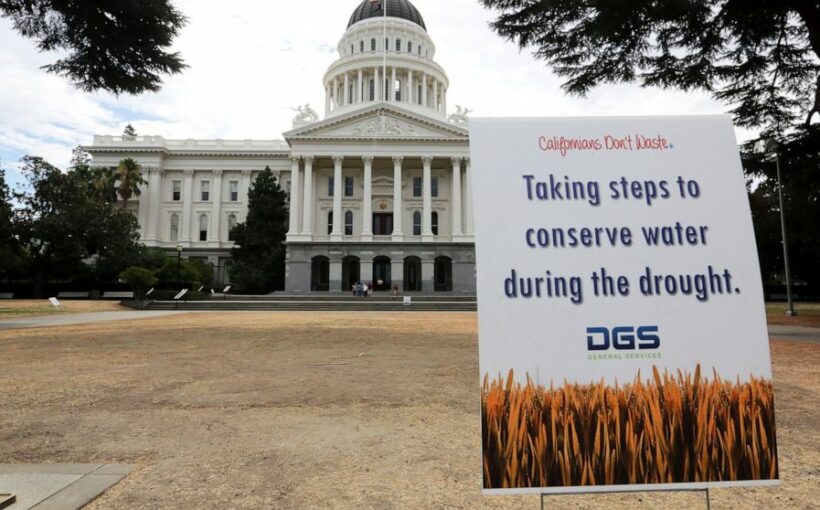SACRAMENTO, Calif. — Standing in the dry, cracked bottom of what should have been a more watery Lake Mendocino, Gov. Gavin Newsom declared a drought emergency Wednesday in two Northern California counties in response to arid conditions affecting much of the state and the West Coast.
The declaration is targeted to Mendocino and Sonoma counties, where drought conditions are especially bad, rather than statewide, as some Central Valley farmers and officials had hoped. But Newsom said a broader drought declaration could come as conditions change.
California, which is now in its second year of drought, is bracing for another devastating wildfire season after a winter with little precipitation.
“Oftentimes we overstate the word historic, but this is indeed an historic moment, certainly historic for this particular lake, Mendocino,” Newsom said, standing where 40 feet (12 meters) of lake water was supposed to be. The lake is at about 40% of normal capacity.
About three-quarters of the western United States is in what is called a megadrought
Last week, hundreds of farmers who rely on a massive irrigation project spanning the Oregon-California border were told they’ll get a fraction of the water they need as federal regulators attempt to balance agriculture with federally threatened and endangered fish species central to the heritage of several tribes.
The two California counties spotlighted by Newsom are part of the Russian River watershed, which is about 110 miles (177 km) long and stretches from the Redwood Valley and Ukiah down to Santa Rosa. Lakes Mendocino and Sonoma are the primary sources of water for residents and commercial users like wineries, and together they provide water for about 600,000 people, said Grant Davis, general manager for Sonoma Water.
Beyond the drought declaration in the two counties, Newsom’s executive order allows the state to prepare for expected effects of the water shortage statewide more quickly. Though he did not declare a statewide drought emergency, the State Water Resources Control Board in March sent early warnings to 40,000 water rights holders urging them to start conserving. The board suggested that agricultural users reduce irrigation and seek other water sources, and that urban users put in drought-resistant landscaping and replace household appliances with water-saving ones.
“If you’re in a different part of the state, you probably need to know that this will one day happen to you,” Karla Nemeth, director of the California Department of Water Resources, said of the drought declaration.
The department says this is the fourth driest year on record statewide, especially in the northern two-thirds of the state. But Newsom said urban Californians are also using 16% less water than they were at the start of the last major drought, which lasted from 2012 to 2016. That drought prompted Gov. Jerry Brown to impose broad restrictions on water use that affected nearly all Californians.
“We’ve barely been out of those drought conditions and here we are entering back into these drought conditions,” he said.
Farmers and leaders in the Central Valley are still hoping for a statewide declaration.
“The Central Valley can’t afford to be overlooked. California is in a drought. We need a statewide emergency declaration immediately in order to deliver more water to farmers and growers in the valley,” Sen. Andreas Borgeas, a Republican who represents Fresno County, said in a statement.
Nemeth, of the Department of Water Resources, said an emergency declaration isn’t yet necessary in the valley because unlike in the Russian River watershed, water users there have access to multiple sources and streams of water. The state’s executive order will not increase the allocation for valley farmers, but it will make it easier to transfer water, she said.
“We’re managing the system just very, very tightly but there aren’t emergency powers that we need to do the things that would help the valley,” she said.
Under Wednesday’s order, the state Water Resources Control Board power can curtail water rights in those counties if major water users do not voluntarily begin to conserve. Some of the largest commercial water users in the region are grape growers and wineries. Local governments could place restrictions on residential water users as part of the conservation effort.
The Russian River watershed is unique in that it relies much more on falling precipitation as it is “geographically isolated” from larger water systems in the state, said Wade Crowfoot, the state’s natural resources secretary.
Without aggressive conservation, the lake is likely to be extremely low by October.
“We could be out of water,” Davis said.
Elsewhere, local water districts are already taking action to address dry conditions. In Marin County, which abuts Sonoma, water officials voted Tuesday night to require residents to reduce water use through measures such as washing vehicles at home and filling backyard pools. People could face fines for violations.
Newsom said he’s not anticipating issuing mandates but said he’s planning for everything.
—-
Antczak reported from Los Angeles. AP writer Janie Har contributed from San Francisco.
Source: Read Full Article
